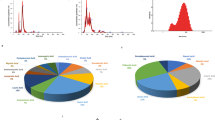Abstract
It has been suggested that IL-1 produces cartilage matrix degradation by metalloproteinases such as collagenase and that such degradation is regulated by metalloproteinase inhibitors. In the present study, the effects of IL-6 and oxygen radical scavengers on cartilage matrix degradation were studied. Superoxide dismutase, catalase, or methionine all significantly inhibited cartilage matrix degradation both in IL-1β-stimulated and unstimulated experimental conditions. Both 10 mM EDTA and 100 nM tissue inhibitor of metalloproteinase (TIMP) significantly inhibited cartilage matrix degradation. The addition of methionine significantly inhibited collagenase activity produced in the culture supernatants of chondrocytes stimulated with IL-1β. IL-6 significantly suppressed cartilage matrix degradation produced spontaneously or by IL-1β stimulation in chondrocytes. IL-6 inhibited superoxide production by chondrocytes both in IL-1β-stimulated or unstimulated conditions. These results suggest that oxygen radicals are involved in cartilage matrix degradation mediated by both paracrine and autocrine IL-1 mechanisms and that oxygen radicalmediated activation of collagenase in chondrocytes may explain the mechanisms of how oxygen radicals are involved in cartilage matrix degradation. IL-6 inhibited superoxide production in chondrocytes and thus inhibited cartilage matrix degradation.
Similar content being viewed by others
References
Kobayashi, I., andM. Ziff. 1975. Electron microscopic studies of the cartilage-pannus junction in rheumatoid arthritis.Arthritis Rheum. 18:475–483.
Ahmadzadeh, N., M. Shingu, andM. Nobunaga. 1990. The effects of recombinant tumor necrosis factor-α on superoxide and metalloproteinase production by synovial cells and chondrocytes.Clin. Exp. Rheumatol. 8:101–105.
Tawara, T., M. Shingu, M. Nobunaga, andT. Naono. 1991. Effects of recombinant human IL-1β on the production of prostaglandin E2, Leukotriene B4, NAG and superoxide by human synovial cells and chondrocytes.Inflammation 15:145–157.
Dayer, J.-M., B. DeRochemoneix, B. Burrus, S. Demczuk, andC. A. Dinarello. 1986. Human recombinant interleukin 1 stimulates collagenase and prostaglandin E2 production by human synovial cells.J. Clin. Invest. 77:645–648.
Dayer, J.-M., M. L. Stephenson, E. Schmidt, W. Karge, andS. M. Krane. 1981. Purification of a factor from human monocyte-macrophages which stimulates the production of collagenase and prostaglandin E2 by cells cultured from rheumatoid synovial tissues.FEBS Lett. 124:254–256.
Murphy, G., E. C. Cartwright, A. Sellers, andJ. J. Reynolds. 1977. The detection and characterization of collagenase inhibitors from rabbit tissues in culture.Biochem. Biophys. Acta 483:493–498.
Cawston, T. E., A. Galloway, E. Mercer, G. Murphy, andJ. J. Reynolds. 1981. Purification of rabbit bone inhibitor of collagenase.Biochem. J. 195:159–165.
Johnson, K. J., andP. A. Ward. 1981. Role of oxygen metabolites in immune complex injury of lung.J. Immunol. 126:2365–2369.
Schraufatatter, I. U., S. D. Revak, andC. G. Cochrane. 1984. Proteases and oxidants in experimental pulmonary inflammatory injury.J. Clin. Invest. 73:1175–1184.
Shingu, M., K. Yoshioka, M. Nobunaga, andK. Yoshida. 1985. Human vascular smooth muscle cells and endothelial cells lack catalase activity and are susceptible to hydrogen peroxide.Inflammation 12:215–222.
McCord, J. M., K. Wong, S. H. Stokes, W. F. Petrone, andD. English. 1980. Superoxide and inflammation: A mechanism for anti-inflammatory activity of superoxide dismutase.Acta Physiol. Scand. 492(Suppl):25–30.
Greenwald, R. A., andW. W. Moy. 1979. Inhibition of collagen gelation by action of the superoxide radical.Arthritis Rheum. 22:251–259.
Bates, E. J., D. A. Lowther, andC. J. Handley. 1984. Oxygen free-radicals mediate an inhibition of proteoglycan synthesis in cultured articular cartilage.Ann. Rheum. Dis. 43:462–469.
Weiss, S. J., G. Peppin, X. Ortiz, C. Ragsdale, andS. T. Test. 1985. Oxidative autoactivation of the latent collagenase by human neutrophils.Science 227:747–749.
Shingu, M., S. Nonaka, H. Nishimukai, M. Nobunaga, H. Kitamura, andK. Tomo-oka. 1992. Activation of complement in normal serum by hydrogen peroxide and hydrogen peroxide-related oxygen radicals produced by activated neutrophils.Clin. Exp. Immunol. 90:72–78.
Weiss, S. J., andS. Regian. 1984. Neutrophils degrade subendothelial matrices in the presence of alpha-1-proteinase inhibitor. Cooperative use of lysosomal proteinases and oxygen metabolites.J. Clin. Invest. 73:1297–1303.
Shingu, M., Y. Nagai, T. Naono, M. Nobunaga, andY. Nagai. 1993. The effects of cytokines on metalloproteinase inhibitors (TIMP) and collagenase production by human chondrocytes and TIMP production by synovial cells and chondrocytes.Clin. Exp. Immunol. 94:145–149.
Hirano, T., T. Taga, N. Nakano, K. Yasukawa, S. Kashiwamura, K. Shimizu, K. Nakajima, K. H. Pyun, andT. Kishimoto. 1985. Purification to homogeneity and characterization of human B cell differentiation factor (BCDF or BSFp-2).Proc. Natl. Acad. Sci. U.S.A. 82:5490–5494.
Kodama, S., K. Iwata, H. Iwata, K. Yamashita, andT. Hayakawa. 1990. Rapid one-step sandwich enzyme immunoassay for tissue inhibitor of metalloproteinases.J. Immunol. Methods 127:103–108.
Carroll, G. J. 1987. Spectrophotometric measurement of proteoglycans in osteoarthritic synovial fluid.Ann. Rheum. Dis. 46:375–379.
Baker, M. S., J. Feigan, andD. A. Lowther. 1989. The mechanism of chondrocyte hydrogen peroxide damage. Depletion of intracellular ATP due to suppression of glycolysis caused by oxidation of glyceraldehyde-3-phosphate dehydrogenase.J. Rheumatol. 16:7–14.
Sato, T., A. Ito, andY. Mori. 1990. Interleukin 6 enhances the production of tissue inhibitor of metalloproteinases (TIMP) but not that of matrix metalloproteinases by human fibroblasts.Biochem. Biophys. Res. Commun. 170:824–829.
Author information
Authors and Affiliations
Rights and permissions
About this article
Cite this article
Shingu, M., Isayama, T., Yasutake, C. et al. Role of oxygen radicals and IL-6 in IL-1-dependent cartilage matrix degradation. Inflammation 18, 613–623 (1994). https://doi.org/10.1007/BF01535259
Issue Date:
DOI: https://doi.org/10.1007/BF01535259




